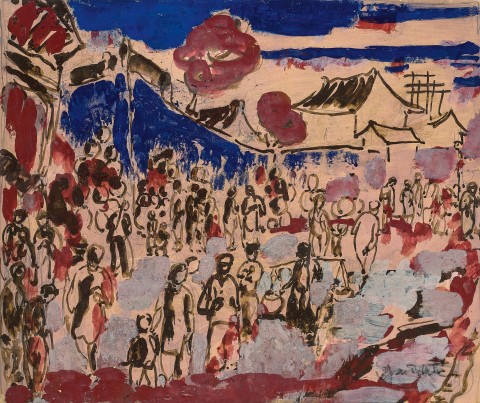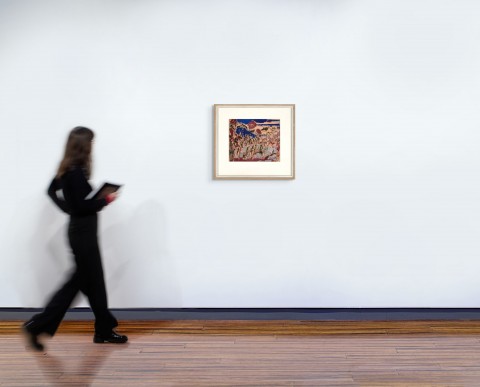PEKING MARKET PLACE, c.1940
IAN FAIRWEATHER
gouache and pencil on paper
36.0 x 43.0 cm
signed lower right: I Fairweather
Lina Bryans, Melbourne
Christie's, Melbourne, 6 March 1970, lot 64 (as ‘Market Place’)
Joseph Brown Gallery, Melbourne
Joan Clemenger AO and Peter Clemenger AO, Melbourne, acquired from the above 6 December 1982
Fairweather: A Retrospective Exhibition, Queensland Art Gallery, Brisbane, 3 June – 4 July 1965, then touring to: Art Gallery of New South Wales, Sydney, 21 July – 22 August 1965; National Gallery of Victoria, Melbourne, 9 September – 10 October 1965; National Gallery of South Australia, Adelaide, 26 October – 21 November 1965; Art Gallery of Western Australia, Perth, 9 December 1965 – 16 January 1966; and Tasmanian Museum and Art Gallery, Hobart, 10 February – 13 March 1966, cat. 79 (as ‘Market Place’)
Joseph Brown Gallery, Melbourne, 10 – 24 September 1981, cat. 139 (illus. in exhibition catalogue, p. 120, as ‘Market Place, 1940 – 41’)
In 1938, Fairweather was living in an abandoned theatre in Sandgate, a seaside suburb of Brisbane. Spooked by inexplicable noises and lights throughout the night, he began both sleeping and working in the old projection room where he could at least close the door to feel more secure. In spite of this he was productive and, as he recounted to his friend Jock Frater, in a few months had completed at least ten works which he intended to send to London for sale.1 Before Fairweather could execute his plan however, Frater managed to sell a large lot to his friend and fellow artist Lina Bryans – ‘the mysterious lady benefactress’2 as Fairweather would call her. Always able to make a simple situation more complicated and fraught, Fairweather – although grateful for Frater’s support – felt humiliated by the process, and it would be some years before he would meet up with Bryans in person.
The works in this group were memories of Peking which he had visited for the first time in 1933 after living in Shanghai for two years. Although only a brief visit, his first impressions were positive, and he was keen to return. For the next year however he circled Southeast Asia, restlessly travelling to Bali, Australia, Colombo and Davao in the Philippines, and finally arriving back in Peking in March 1935. He found the city much changed, he wrote in a letter to Jim Ede, and ‘full of refugee Russians’ who competed for the sort of unskilled work he depended upon while waiting for money from the sale of his paintings in London.3 All that was left to do was to walk the city, drawing and sketching the temples and bridges, the walls and canals, the crowded markets and busy street stalls. Peking was messy and noisy and, though preferable to the monotony of Melbourne and the irritations of Davao, drove him to distraction. As he found in most instances, places and people were much better after the fact.
Such depictions of China are now considered amongst Fairweather’s finest works, and indeed the present, Peking Market Place, c.1940, has all the immediacy and vividness of a photograph snapped in the street. The dark brown and cream figures form a long serpentine line set against a vivid background of indigo blue, a colour used frequently in Chinese ink paintings, with other details picked out in a deep russet. It offers a fleeting impression quickly and perfectly sketched.
1. Roberts, C. and Thompson, J., Ian Fairweather: A Life in Letters, Text Publishing, Melbourne, 2019, p. 123
2. ibid.
3. ibid.
DR CANDICE BRUCE


